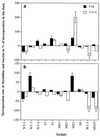Interspecific variability in sensitivity to UV radiation and subsequent recovery in selected isolates of marine bacteria
- PMID: 10742228
- PMCID: PMC92009
- DOI: 10.1128/AEM.66.4.1468-1473.2000
Interspecific variability in sensitivity to UV radiation and subsequent recovery in selected isolates of marine bacteria
Abstract
The interspecific variability in the sensitivity of marine bacterial isolates to UV-B (295- to 320-nm) radiation and their ability to recover from previous UV-B stress were examined. Isolates originating from different microenvironments of the northern Adriatic Sea were transferred to aged seawater and exposed to artificial UV-B radiation for 4 h and subsequently to different radiation regimens excluding UV-B to determine the recovery from UV-B stress. Bacterial activity was assessed by thymidine and leucine incorporation measurements prior to and immediately after the exposure to UV-B and after the subsequent exposure to the different radiation regimens. Large interspecific differences among the 11 bacterial isolates were found in the sensitivity to UV-B, ranging from 21 to 92% inhibition of leucine incorporation compared to the bacterial activity measured in dark controls and from 14 to 84% for thymidine incorporation. Interspecific differences in the recovery from the UV stress were also large. An inverse relation was detectable between the ability to recover under dark conditions and the recovery under photosynthetic active radiation (400 to 700 nm). The observed large interspecific differences in the sensitivity to UV-B radiation and even more so in the subsequent recovery from UV-B stress are not related to the prevailing radiation conditions of the microhabitats from which the bacterial isolates originate. Based on our investigations on the 11 marine isolates, we conclude that there are large interspecific differences in the sensitivity to UV-B radiation and even larger differences in the mechanisms of recovery from previous UV stress. This might lead to UV-mediated shifts in the bacterioplankton community composition in marine surface waters.
Figures





References
-
- Aas P, Lyons M M, Pledger R, Mitchell D L, Jeffrey W H. Inhibition of bacterial activities by solar radiation in nearshore waters and the Gulf of Mexico. Aquat Microb Ecol. 1996;11:229–238.
-
- Behr H D. Net total and UV-B radiation at the sea surface. J Atmos Chem. 1992;15:299–314.
-
- Berger B, Hoch B, Kavka G, Herndl G J. Bacterial metabolism in the River Danube: parameters influencing bacterial production. Freshw Biol. 1995;34:601–616.
Publication types
MeSH terms
Substances
LinkOut - more resources
Full Text Sources

